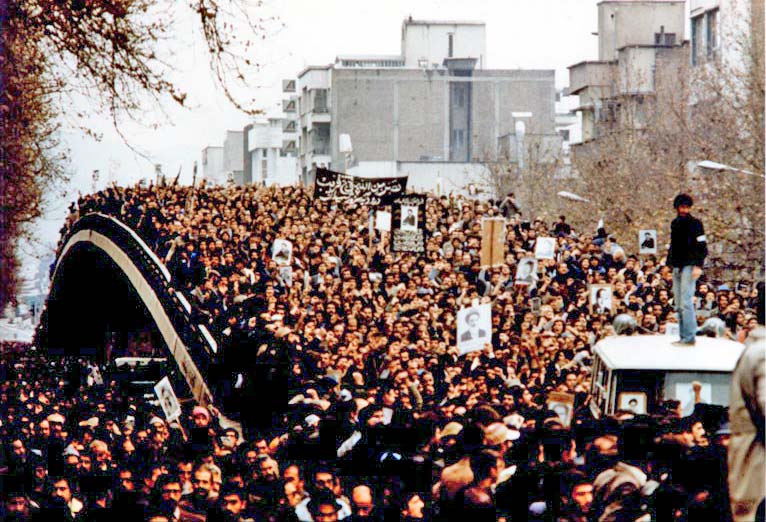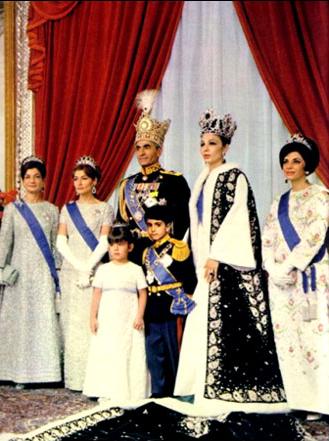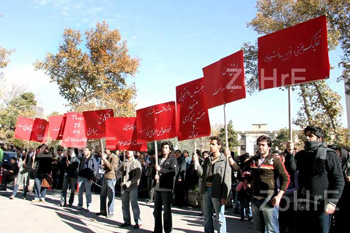This month marks the 30th anniversary of the Iranian revolution and the mainstream media around the world is pumping out stories about the role of the Islamic clergy in the revolution, particularly the role of Ayatollah Khomeini. If one were to limit oneself to reading these stories it would appear that the Iranian working class hardly had a look in into those tumultuous events of February 1979.
The truth is that the 1979 revolution in Iran was a workers’ revolution. Had it not been for the mobilisations of the working class, the Ayatollah and his friends would have remained in exile in France waiting for better days. Instead on February 1, 1979 Khomeini was able to return to Iran to be welcomed by a huge crowd of millions. Are we really to believe that this one man provoked and led the revolution? The truth is that he stepped into a situation that had been brewing for some time.
In fact, already one year earlier workers and youth had dared to challenge on the streets the hated SAVAK, the Shah’s secret police. Before those events the SAVAK was quoted as one of the most powerful and impregnable machines of repression the world had ever seen. And yet once the masses began to move it was not long before this hated force melted away, many of its members throwing away their uniforms for fear of reprisal at the hands of the working people. They had good reason to be worried, as they had carried out abominable acts of brutality, such as shooting on unarmed demonstrators with machine guns from helicopters!
Why do the media today not highlight such facts? The fact is that the governments of countries such as France, Britain and the USA (as well as the Russian bureaucracy) supported the Shah. His dictatorial regime was considered a strong ally in this oil-rich region of the world. The imperialists supported the Shah over a long period of decades. They only withdrew support when they realised that to keep him in power meant provoking a revolution from below that could have threatened their vital interests.
Under the Shah, the industrialisation of the country had produced a modern proletariat of millions, a proletariat that was destined to play a key role in the revolution. Of crucial importance was the movement of the oil workers. Until then many on the left had written off this section of the working class as a so-called “privileged” sector. But at a key moment these workers did move and, considering the importance of the oil industry in the Iranian economy, this marked the end of the regime.

In the process of the rising militancy of the Iranian working class de facto Soviets, the workers’ councils, were thrown up as expressions of genuine workers’ power. The movement of the masses seemed all-powerful. It was so powerful that the army itself melted away, with many of the lower ranks and even some of the officers siding with the people. The once mighty regime of the Shah collapsed like a house of cards.
However, it would also be true to say that no single party led the Iranian February revolution. What was striking was that in spite of this lack of leadership, the workers revealed an amazing ability to organise from below. Workers in the factories took over their running and set up workers’ councils; the peasants also moved taking over the land; and the long oppressed national minorities also began to express their desire for autonomy. The students were extremely radicalised and all kinds of socialist and Marxist discussion circles and groups sprang up.
All the conditions existed for a rapid movement towards the setting up of a genuine workers’ government in Iran. Had this materialised we would have seen a healthy workers’ state being set up, the first of its kind since the Russian revolution in 1917. This would have transformed the whole balance of forces throughout the Middle East and beyond. A successful coming to power of the Iranian working class in 1979 would have marked the end of one despotic regime after another in the region, as similar conditions existed in the surrounding countries. Had this happened, the whole history of the region would have been different. It would have been the first step in the building of a genuine Socialist Federation of the Middle East.
Tragically, in spite of the immense revolutionary energy expressed by the workers, the Iranian working class was to be pulled back from carrying out a socialist revolution to the very end by that party that in theory was supposed to lead such a revolution, the Tudeh party (Communist Party). This was not to be the first, nor the last time that a Communist Party with a Stalinist leadership would play such a treacherous role.
In the context of the then balance of forces between the major powers, namely the USA and the USSR, Iran was to remain under the sphere of influence of the United States. The Soviet bureaucracy had no interest in promoting any kind of revolutionary policy in Iran and the Tudeh party obediently carried out a policy based on the idea that the conditions in Iran were not mature for socialist revolution. Their perspective was one of the “democratic revolution”, i.e. the bourgeois revolution. That explains why they sought a “progressive bourgeoisie”, that the labour movement was to support.

The fact is that there was no such class in Iran. The bourgeoisie internationally had long ago lost any progressive connotations it may have had in the distant historical past. Nonetheless, the Tudeh party insisted on this policy and that explains why they started to portray the Ayatollahs as somehow “progressive”. Because the organisations of the working class, and in particular the Tudeh party itself, had not organised opposition from below within the labour movement, opposition voices found expression through the mosques.
The Islamic clergy had come into conflict with the regime over the Shah’s dispossession of its lands. The clergy began voicing opposition in the mosques and this connected with the real mass opposition that was brewing among the working people. The Tudeh by declaring the Islamic clergy as progressive enhanced the image of the Ayatollahs in the eyes of the masses, giving them almost a kind of left-wing credential.
Thus what was a revolution was strangled and in its place came the counter-revolution of the Ayatollahs. This reactionary Islamic clergy initially had to move carefully as the movement that had been unleashed from below could not be snuffed out in one go. The workers still had their organisations; the revolutionary fervour was still alive.
The movement that had started in 1977 led to the overthrow of the Shah in 1979 and lived on until 1981, when the new Islamic regime felt stronger, and was finally destroyed by 1983. In that same year, the regime proceeded to ban the Tudeh, in spite of the fact that this party had actually contributed to giving the Ayatollahs an aura of progressiveness. Again, there was nothing new in this. How many times in history have we seen the reformists and Stalinists hold back the masses, only to be severely repressed themselves later on by the very regimes they have helped to preserve?
Thus, the Ayatollahs, under the guise of “defending the revolution”, carried out a systematic counter-revolution, destroying any genuine expression of workers’ power, of workers’ democracy and gradually built up a despotic regime, where capitalism survived and where all real democratic rights were snuffed out.
The Iranian workers paid a heavy price for the policies adopted by the Tudeh leadership at the time. Many of the best workers and youth lost their lives in the Ayataollahs’ prisons, first tortured and then brutally murdered. And the working class as a whole has paid the price of losing its genuine organisations that had been thrown up by the revolution. What had started as a real movement of the working class, a socialist revolution in the making, was unfortunately, hijacked by the fundamentalist mullahs.

Today, thirty years later, Iran is once again facing revolutionary upheaval. In the past years we have seen several waves of student protests and many militant strikes. The Islamic regime is still in power but its grip has been loosened. The Iranian economy is facing a serious crisis, especially now with the collapse in the price of oil. The regime has less room to manoeuvre than in the past.
There is also a completely new generation of workers and students. Most of Iran’s population was born after the 1979 revolution. But that is also why the lessons of the past need to be absorbed by this younger generation. This generation has lost any illusions in the Islamic clergy that there may have been in the past. These clerics, who stole the clothing of the 1979 revolution, only to proceed to betray everything the revolution stood for, are now hated by the masses. It is only a matter of time before a new revolutionary wave of struggle topples them from power.
And whereas in 1979 the Ayatollahs were able to present themselves as somehow an alternative to the Shah and the imperialists that backed him, this time round they will not be able to fool the people. Islamic fundamentalism is utterly reactionary and the regime in Iran stands there for all to see this.
The workers and youth who will mobilise in the next Iranian revolution can only turn in one direction, to the ideas of genuine Marxism. That is why today we are reminding our readers of two key articles that have appeared on our website.
One is The Iranian Revolution written by Ted Grant in February 1979, which explains how the hated regime of the Shah was overthrown by a workers’ revolution, but was then hijacked by the fundamentalist mullahs.
The other article was written in two parts, Revolution and Counter-revolution in Iran: A Marxist View – Part One and Revolution and Counter-revolution in Iran: A Marxist View – Part Two. This was produced by the HKS, Iranian Socialist Workers Party in 1983, who had actively participated in the revolution. It provides an excellent analysis of the whole process. The second part of the article deals with the rise of the revolutionary movement in Iran in 1978 and how the counterrevolutionary forces around Khomeini were able to take a complete hold on power, mainly due to the failure of the left-wing parties to provide a revolutionary strategy.
In spite of the tremendous difficulties of the past 30 years, the voice of genuine Marxism has not been snuffed out. The memory of 1979 lives on still and is embodied in the Iranian Revolutionary Marxists’ Tendency (see The political situation in Iran and the need to form the Iranian Revolutionary Marxists’ Tendency). These comrades base themselves on the analysis outlined in the above articles. They have learnt from the experience of the Iranian Marxists in 1979. By learning from past mistakes, the new generation of workers and youth in Iran can prepare themselves for the coming period. History is providing a new opportunity. It must not be wasted!

